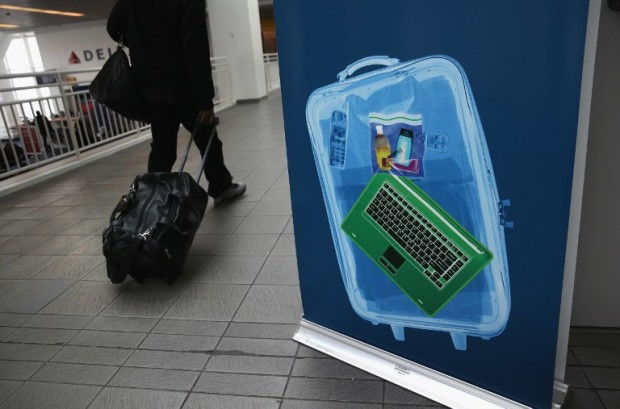
This file photo taken on Jan. 26, 2014, shows a traveler walking past a newly-opened TSA Pre-check application center at Terminal C of the LaGuardia Airport. The United States is banning large electronic devices such as laptops or cameras on board flights from up to a dozen Middle East nations. AFP
WASHINGTON, United States — From toothpaste to pocket knives, ink cartridges and scissors, the US cabin ban on electronic devices on flights from the Middle East and North Africa adds to a long list of products already blacklisted on international flights.
Britain issued a similar order concerning direct flights from a shorter list of countries and other countries are expected to follow suit
Here is a list of terror incidents that led international transport authorities to ban many everyday consumer goods from flight cabins:
READ: US, Britain ban laptops on flights from Turkey and Arab world
9/11: the turning point
After hijackers flew passenger jets into the Twin Towers in New York on September 11, 2001, in-flight security was massively stepped up around the world.
All blades — both blunt and sharp, including scissors and pocket-knives — were banned from passengers’ carry-on luggage and relegated to the flight hold.
Blunt objects such as baseball bats, truncheons and martial arts instruments were forbidden, along with imitation firearms.
Shoe bomber
On December 22, 2001, British national Richard Reid was overpowered on an American Airlines flight from Paris to Miami while trying to detonate explosives hidden in his shoes.
Travelers can now be asked to remove their shoes and pass them through an X-Ray machine with the rest of their carry-on items.
On Christmas Day 2009, Umar Farouk Abdulmutallab of Nigeria tried in vain to detonate plastic explosives concealed in his underwear on a plane approaching Detroit on a flight from Amsterdam.
Liquid explosives
On August 10, 2006, British authorities announced they had foiled a terror plot that aimed to blow up several planes in mid-air simultaneously with liquid explosives.
Since then, tough restrictions have applied to liquids and gels, such as toothpaste. One exception is infant formula, which must be tested before being taken on the plane.
Containers with no more than 100 milliliters (four ounces) of liquid are allowed if they are placed in sealable plastic bags.
As is the case with other banned objects — such as knives — liquids can be purchased, even in large amounts, before passengers board the plane, from outlets located beyond airport security checkpoints.
Rigged printers
Packages destined for the US and containing explosives hidden in printer cartridges and with a detonator were intercepted on October 28, 2010 in Dubai and London.
So printer cartridges are now banned from flights, even inside checked luggage, as are all flammable products.
The explosive liquid in question — pentaerythritol tetranitrate, or PETN, is the same material that Reid and Abdulmutallab had tried to use.
Laptops under scrutiny
On February 2, 2016, an explosion aboard an Airbus A321 plane operated by Somali-owned Daallo Airlines created a hole that was about a meter (more than three feet) in diameter in the fuselage.
Only the suspect was killed in the attack claimed by Shabaab militants affiliated with Al-Qaeda. Two passengers suffered minor wounds. The pilot was able to make an emergency landing.
Surveillance footage of the suspect before boarding suggests he may have hidden the explosives in his laptop.
Increased security measures for electronics have already been in place since 2014, and passengers can be asked to turn their computer and cellphones on for verification prior to boarding.
Lithium batteries
After multiple in-flight incidents involving lithium-ion batteries that caught on fire, they have been subjected to strict restrictions since April 2016 and can no longer be placed in the hold.
Lithium batteries are seen as a possible cause for the March 2014 disappearance of Malaysia Airlines Flight MH370 that was transporting a package containing hundreds of kilograms of these types of batteries.
Passenger electronics such as computers, smartphones and tablets were until now not seen as a major concern, and until the latest measures, passengers often kept them in the cabin. CBB